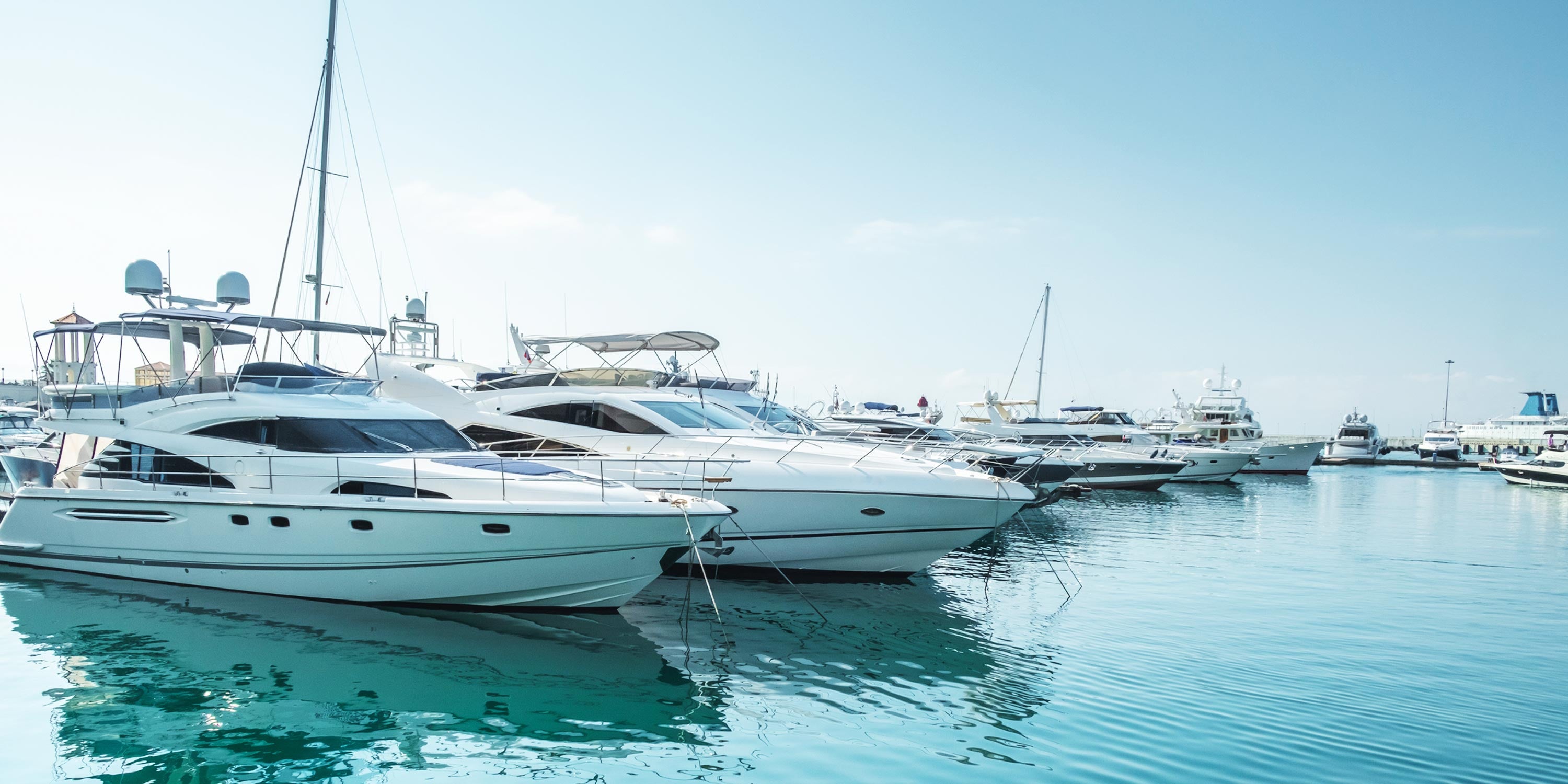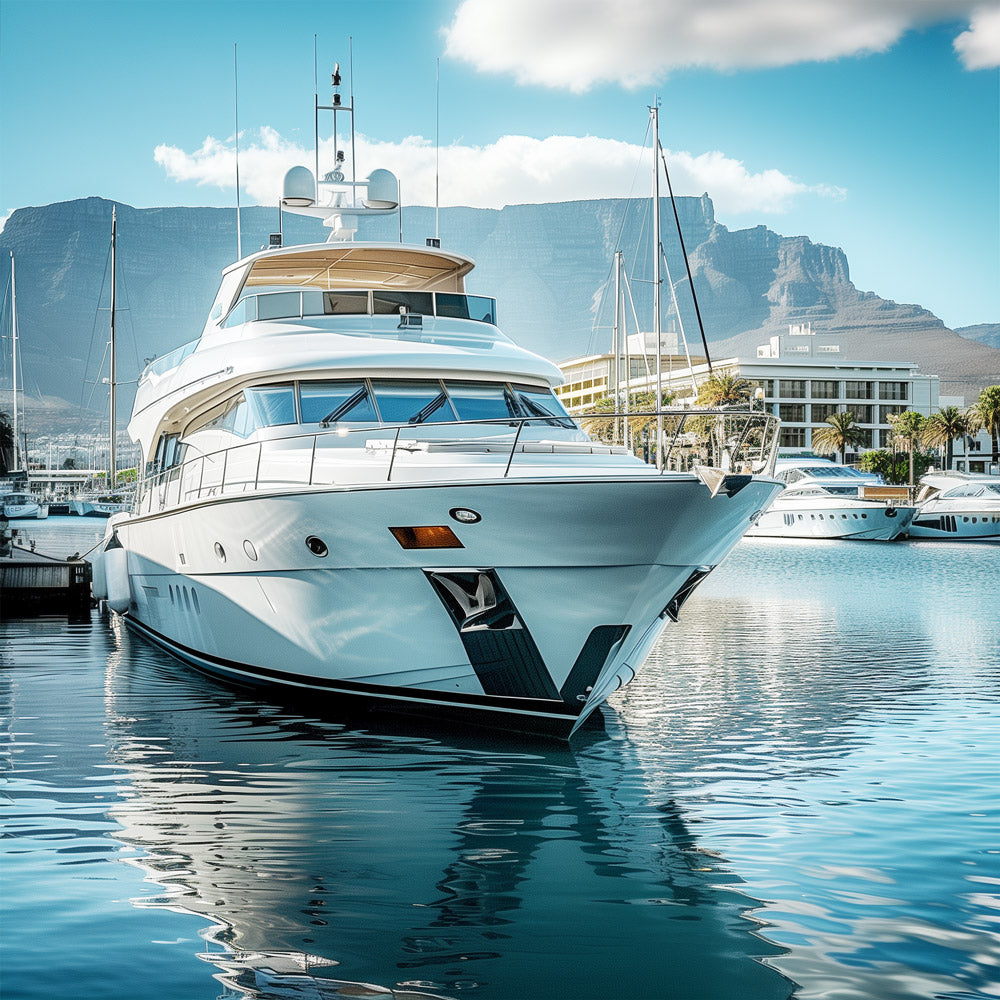

Weshalb ein Batteriemonitor für Boote sinnvoll ist?
Ein Batteriemonitor für eine Bootsbatterie ist sinnvoll, um die Gesundheit und Leistung der Batterien zu überwachen. Der Batterieprüfer und Battery Guard zeigt den aktuellen Ladezustand, die verbleibende Batteriekapazität und die Lade-/Entladeströme an. Dies verhindert unerwartete Batterieausfälle, optimiert die Nutzung und verlängert die Lebensdauer der Starterbatterie.
Weshalb ein Batteriemonitor für Boote sinnvoll ist?
Ein Batteriemonitor für eine Bootsbatterie ist sinnvoll, um die Gesundheit und Leistung der Batterien zu überwachen. Der Batterieprüfer und Battery Guard zeigt den aktuellen Ladezustand, die verbleibende Batteriekapazität und die Lade-/Entladeströme an. Dies verhindert unerwartete Batterieausfälle, optimiert die Nutzung und verlängert die Lebensdauer der Starterbatterie.

Batteriecomputer per WLAN & Bluetooth
Weltweite Datenübertragung kostenlos per WLAN - keine fortlaufenden Mobilfunkkosten
Energie- & Akkuüberwachung
Stromverbrauch (Ampere) und Batteriespannung (Volt) aller Bootsbatterien jederzeit und überall überwachen
Batteriestatus global prüfen
Abruf der Batteriewerte von Ihrem Boot weltweit per App
Umgebungsmonitoring
Erfassung von Umgebungsparametern wie Temperatur, Luftfeuchte und WLAN-Status
.
Produkt

Unser Batteriewächter - Deine Vorteile
Ein Batteriewächter für Boote & Yachten: Alle Vorteile in einem Gerät vereint.
✓ Sicherheitssteigerung: Echtzeitüberwachung der Batterieparameter per Bluetooth Konnektivität und Temperatursensor verhindert potenzielle Gefahren und erhöht die Sicherheit an Bord.
✓ Optimierte Energieeffizienz: Präzise Daten vom Batteriemessgerät zur Batterie ermöglichen eine Anpassung der Energieverbrauchsmuster zur Effizienzsteigerung.
✓ Längere Batterielebensdauer: Vermeidung von Über- und Tiefentladung sorgt für eine längere Lebensdauer der Batterien sowie Batterieleistung.
✓ Benutzerfreundlich und zugänglich: WLAN-gestütztes Remote Monitoring und -steuerung erleichtert die Nutzung, selbst fernab vom Boot oder Floating Home.
✓ Langfristige Kosteneinsparungen: Effizientes Batteriemanagement reduziert Austauschkosten und optimiert den Energieverbrauch, was zu finanziellen Einsparungen führt.
Unser Batteriewächter - Deine Vorteile
Ein Batteriewächter für Boote & Yachten: Alle Vorteile in einem Gerät vereint.
✓ Sicherheitssteigerung: Echtzeitüberwachung der Batterieparameter per Bluetooth Konnektivität und Temperatursensor verhindert potenzielle Gefahren und erhöht die Sicherheit an Bord.
✓ Optimierte Energieeffizienz: Präzise Daten vom Batteriemessgerät zur Batterie ermöglichen eine Anpassung der Energieverbrauchsmuster zur Effizienzsteigerung.
✓ Längere Batterielebensdauer: Vermeidung von Über- und Tiefentladung sorgt für eine längere Lebensdauer der Batterien sowie Batterieleistung.
✓ Benutzerfreundlich und zugänglich: WLAN-gestütztes Remote Monitoring und -steuerung erleichtert die Nutzung, selbst fernab vom Boot oder Floating Home.
✓ Langfristige Kosteneinsparungen: Effizientes Batteriemanagement reduziert Austauschkosten und optimiert den Energieverbrauch, was zu finanziellen Einsparungen führt.

Batteriemanagement mit WLAN + Batteriemonitor
Das HOOTS Batteriemanagement mit WLAN und Batteriemonitor ist eine fortschrittliche Lösung für Boote und Hausboote. Diese Technologie ermöglicht eine effiziente Überwachung und Steuerung der Batteriesysteme, was für die sichere und effiziente Energieverwaltung in solchen Umgebungen entscheidend ist.

Einsatz in Booten und Floating Homes
In diesen Umgebungen ist das Batteriemanagement besonders wichtig, da die Energieversorgung oft isoliert und von kritischer Bedeutung ist. Ein WiFi / WLAN-fähiges Batteriemanagementsystem bietet eine bequeme und effiziente Lösung, um die Energiequellen optimal zu nutzen und gleichzeitig die Sicherheit und den Komfort an Bord zu gewährleisten
Einsatz in Booten und Floating Homes
In diesen Umgebungen ist das Batteriemanagement besonders wichtig, da die Energieversorgung oft isoliert und von kritischer Bedeutung ist. Ein WiFi / WLAN-fähiges Batteriemanagementsystem bietet eine bequeme und effiziente Lösung, um die Energiequellen optimal zu nutzen und gleichzeitig die Sicherheit und den Komfort an Bord zu gewährleisten

Hauptmerkmale und Vorteile
Batterieüberwachung auf Top-Level
Alle Features und wichtige Funktionen unseres Batteriemanagementsystems für Boot und Yacht im Überblick
WLAN / WiFi-Konnektivität
Bietet die Möglichkeit zum Remote Monitoring und -steuerung der Batterien mittels Smartphone, Tablet oder Computer. Anwender können Batteriestatus Informationen per Batteriemessgerät live überprüfen und Einstellungen bequem aus der Ferne ändern.
HOOTS Batterieüberwachung Boot
Die Technologie gewährt detaillierte Einblicke in kritische Batterieparameter wie Spannung, Strom, Ladelevel, Entladezyklen und Temperatur. So lässt sich der Zustand des Akkumulators exakt überwachen.
HOOTS Echtzeit-Alarme und Benachrichtigungen
Das System alarmiert Anwender bei gefährlichen Batteriezuständen wie Überladung, Tiefentladung oder ungewöhnlichen Temperaturveränderungen.
HOOTS Datenanalyse und -aufzeichnung
Durch die Messung und Langzeitaufzeichnung von Daten können Nutzungstrends und Muster des Akkumulators untersucht werden, um die Lebensdauer der Batterie gezielt zu verbessern.
Integration in bestehende Systeme
Das System kann leicht in bestehende Energieinfrastrukturen eingebunden werden, einschließlich Solarpanels, Generatoren und Wechselrichter, für eine reibungslose Integration.

Boot-Überwachung auf Performance-Level
Unser Boot-Batterieüberwachungssystem bietet eine zuverlässige und benutzerfreundliche Lösung zur Überwachung der Batterien auf Ihrem Boot.
Mit präzisen Echtzeitdaten zu Spannungs- und Ladezustand können Sie sicherstellen, dass Ihre Batterien immer optimal funktionieren. Die Bluetooth-App ermöglicht eine bequeme Fernüberwachung und Benachrichtigungen direkt auf Ihr Smartphone. Durch den Einsatz dieses Systems vermeiden Sie unerwartete Ausfälle und verlängern die Lebensdauer Ihrer Batterien. Vertrauen Sie auf modernste Technologie für mehr Sicherheit und Effizienz auf dem Wasser.
Boot-Überwachung auf Performance-Level
Unser Boot-Batterieüberwachungssystem bietet eine zuverlässige und benutzerfreundliche Lösung zur Überwachung der Batterien auf Ihrem Boot.
Mit präzisen Echtzeitdaten zu Spannungs- und Ladezustand können Sie sicherstellen, dass Ihre Batterien immer optimal funktionieren. Die Bluetooth-App ermöglicht eine bequeme Fernüberwachung und Benachrichtigungen direkt auf Ihr Smartphone. Durch den Einsatz dieses Systems vermeiden Sie unerwartete Ausfälle und verlängern die Lebensdauer Ihrer Batterien. Vertrauen Sie auf modernste Technologie für mehr Sicherheit und Effizienz auf dem Wasser.


Echtzeit-Überwachung und Benachrichtigungen
Das Boot-Batterieüberwachungssystem bietet präzise Echtzeitdaten zur Spannungs- und Ladezustand der Batterien auf Ihrem Boot. Diese Daten können jederzeit über eine benutzerfreundliche Bluetooth-App auf Ihrem Smartphone abgerufen werden.
Dadurch haben Sie immer einen genauen Überblick über den Zustand Ihrer Batterien und können frühzeitig reagieren, wenn die Leistung nachlässt oder eine Wartung erforderlich ist.
Echtzeit-Überwachung und Benachrichtigungen
Das Boot-Batterieüberwachungssystem bietet präzise Echtzeitdaten zur Spannungs- und Ladezustand der Batterien auf Ihrem Boot. Diese Daten können jederzeit über eine benutzerfreundliche Bluetooth-App auf Ihrem Smartphone abgerufen werden.
Dadurch haben Sie immer einen genauen Überblick über den Zustand Ihrer Batterien und können frühzeitig reagieren, wenn die Leistung nachlässt oder eine Wartung erforderlich ist.


Verlängerung der Batterielebensdauer
Mit der genauen Überwachung der Batteriezustände können Sie die Nutzung Ihrer Batterien optimieren und ihre Lebensdauer erheblich verlängern.
Durch rechtzeitige Benachrichtigungen bei kritischen Zuständen vermeiden Sie Tiefenentladungen und andere schädliche Einflüsse, die die Batterie dauerhaft beschädigen könnten. Dies sorgt nicht nur für mehr Sicherheit auf dem Wasser, sondern spart auch langfristig Kosten durch die Reduzierung der Häufigkeit von Batteriewechseln.
Verlängerung der Batterielebensdauer
Mit der genauen Überwachung der Batteriezustände können Sie die Nutzung Ihrer Batterien optimieren und ihre Lebensdauer erheblich verlängern.
Durch rechtzeitige Benachrichtigungen bei kritischen Zuständen vermeiden Sie Tiefenentladungen und andere schädliche Einflüsse, die die Batterie dauerhaft beschädigen könnten. Dies sorgt nicht nur für mehr Sicherheit auf dem Wasser, sondern spart auch langfristig Kosten durch die Reduzierung der Häufigkeit von Batteriewechseln.

Fragen & Antworten
Wissenswertes über unsere Produkte im Bereich Boot & Marine
Wie funktioniert ein Batteriemonitor für Boote?
Ein Batteriemonitor und BATTERY Guard für Boot und Yacht funktioniert, indem er den Ladezustand und die Leistung der Batterie in Echtzeit überwacht. Das Gerät misst kontinuierlich Spannung, Strom und Temperatur der Batterie. Diese Daten werden durch Sensoren und einen Mess-Anschluss erfasst.
Die gesammelten Informationen werden als Basis auf einem Display oder über eine App auf einem Smartphone oder Tablet angezeigt.
Moderne Batteriemonitore für die Yacht bieten zudem Funktionen wie historische Datenaufzeichnung und Alarmmeldungen bei kritischen Zuständen und Verbrauch von Lade-/Entladestrom. Einige Modelle verfügen über Bluetooth-Konnektivität für eine einfache Parameter Fernüberwachung.
Diese Funktionen sind besonders nützlich für die sichere und effiziente Energieverwaltung an Bord von Booten, da sie helfen, unerwartete Batterieausfälle sowie Entladung zu verhindern und eine zuverlässige Stromversorgung sicherzustellen.
Wie kann ich testen ob eine 12V Batterie leer ist?
1. Visuelle Inspektion: Prüfen Sie die Batterie auf sichtbare Schäden oder Korrosion an den Anschlüssen.
2. Verwendung eines Voltmeter bzw. Batterie Monitor: Schließen Sie ein Voltmeter an die Batterie an. Eine voll aufgeladene 12V Batterie sollte zwischen 12,6 und 12,8 Volt anzeigen. Eine Spannung unter 12,4 Volt deutet darauf hin, dass die Batterie teilweise entladen ist, während eine Spannung unter 12,0 Volt darauf hinweist, dass die Batterie stark entladen oder leer ist.
3. Lasttest: Verwenden Sie einen Lasttester, um die Batterie unter Belastung zu prüfen. Dies simuliert den Startvorgang und zeigt an, ob die Batterie genügend Strom liefern kann.
4. Batteriewächter und Batterieüberwachungssysteme: Diese Systeme überwachen kontinuierlich den Ladezustand bzw. die Batteriespannung und die Leistungsfähigkeit der Batterie und geben Warnmeldungen aus, wenn die Batterie schwach oder leer ist.
Was passiert wenn der Messshunt nicht mehr funktioniert?
Ein Shunt ist ein Gerät, das in Strommesskreisen verwendet wird, um den Stromfluss und Batteriezustand zu überwachen. Wenn ein Shunt nicht mehr richtig funktioniert, kann dies mehrere Probleme verursachen:
- Fehlende Strommessung: Der Hauptzweck eines Shunts ist es, den Stromfluss genau zu messen. Wenn der Shunt nicht funktioniert, ist die genaue Messung des Stroms nicht mehr möglich, was zu Problemen bei der Überwachung und Management einer Yacht führen kann.
- Fehlerhafte Stromüberwachung: Ein defekter Messshunt kann falsche oder unzuverlässige Strommesswerte liefern. Aus diesem Grund kann dies zu falschen Annahmen über den Stromverbrauch führen, was wiederum zu ineffizienter Nutzung von elektrischen Systemen führt.
- Systemausfälle: In Systemen, die stark von der genauen Stromüberwachung abhängen, wie zum Beispiel in Solaranlagen oder Batterieüberwachungssystemen, kann ein Elektronik Defekt des Shunts zu Ausfällen des gesamten Systems führen.
Wie funktioniert ein Batteriemonitor mit WLAN und Bluetooth für Boote?
Ein Batteriemonitor mit WLAN und Bluetooth für Boote ermöglicht eine fortgeschrittene Überwachung und Steuerung der Stromspeicher. Über WLAN kann dieses Produkt die Batterieparameter der Bootselektrik bequem über eine App auf dem Smartphone oder Tablet abgerufen werden, auch wenn sich der Benutzer nicht direkt am Boot befindet.
Bluetooth ermöglicht eine direkte Verbindung zwischen dem Monitor und dem mobilen Gerät in unmittelbarer Nähe. So können detaillierte Echtzeitdaten und Informationen von diesem Produkt wie Spannung, Stromstärke, Ladezustand und Temperatur der Batterien überwacht werden. Benutzer erhalten ohne Anleitung bei dieser Methode Batteriedaten Grenzwerte und Warnungen bei kritischen Zuständen wie Überladung oder Tiefentladung.
Welche Batterien für Boote gibt es und welche brauche ich?
Es gibt verschiedene Arten von Boots- und Yachtbatterien:
- Startbatterien (Starterbatterien): Diese Batterien liefern kurzzeitig hohe Ströme, um den Bootsmotor einer Yacht zu starten. Blei-Säure-Batterien sind zum Beispiel für den schnellen Entladungs- und Wiederaufladungsprozess ausgelegt.
- Verbraucherbatterien (Versorgungsbatterien): Diese Batterien sind für die Versorgung des Systems sowie elektrischer Verbraucher an Bord gedacht, wie Beleuchtung, Pumpen und elektronische Geräte.
- Tiefzyklus-Batterien: Diese Batterien können tiefer entladen werden und eignen sich daher gut für Anwendungen, bei denen regelmäßige Tiefentladungen auftreten können, wie bei elektrischen Ankerwinden oder elektrischen Antrieben.
Weshalb ein Batteriewächter für Boote im Winterlager?
Ein Batteriewächter und SmartShunt für Boote im Winterlager ist wichtig, um den Akkumulator und Batteriekapazität während der Lagerung an Bord zu überwachen und deren Zustand zu erhalten. Während des Winters können Batterien sowie die Elektronik durch Kälte und Langzeitlagerung Schaden nehmen.
Durch regelmäßige Messungen der Parameter der Yacht kann man sicherstellen, dass die Stromspeicher nicht entladen werden oder unter ungünstigen Bedingungen leiden, die zu Schäden auch am Gehäuse führen könnten.
Zusätzlich ermöglicht die Fernüberwachung über WLAN oder Bluetooth mit einem WLAN Battery Guard den Zugriff und Überblick auf die Batteriedaten, ohne dass physischer Zugang zum Boot erforderlich ist.
Noch mehr Wissen
Die Boot Batterie im Winter laden oder ausbauen bzw. abklemmen?
Im Winter ist es wichtig, die Bootsbatterie richtig zu pflegen, um ihre Lebensdauer zu maximieren. Es gibt zwei Hauptoptionen:
1. Ausbauen und Lagern: Entfernen Sie die Batterie und lagern Sie sie an einem kühlen, trockenen Ort. Laden Sie sie alle paar Monate auf, um die Ladung zu erhalten.
2. Im Boot lassen und Laden: Wenn die Batterie im Boot bleibt, trennen Sie sie von den elektrischen Systemen und nutzen Sie ein Erhaltungsladegerät. Dieses Gerät hält die Batterie geladen und verhindert Tiefentladungen.
Beide Methoden schützen die Batterie vor Kälte und verhindern Schäden, die durch Tiefentladungen entstehen können.
Wie kann ich die Luftfeuchte bzw. Temperatur im Boot messen?
Um die Luftfeuchte und Temperatur im Boot zu messen, können Sie ein digitales Hygrometer und Thermometer verwenden. Diese Geräte sind einfach zu installieren und bieten präzise Messwerte.
- Digitale Hygrometer/Thermometer: Diese Geräte messen sowohl die Luftfeuchtigkeit als auch die Temperatur. Platzieren Sie sie an einem zentralen Ort im Boot für genaue Messungen.
- Multifunktionale Wetterstationen: Einige Modelle bieten zusätzliche Funktionen wie Druckmessung und Wettervorhersagen.
- Smart-Sensoren: Diese modernen Geräte verbinden sich über Bluetooth oder WLAN mit Ihrem Smartphone und ermöglichen die Fernüberwachung.
Regelmäßige Überwachung hilft, Schimmelbildung zu verhindern und ein angenehmes Klima im Boot zu gewährleisten.
Wie viel Ah (Amperestunden) für eine Bootsbatterie bzw. Versorgungsbatterie?
Die benötigte Kapazität einer Bootsbatterie oder Versorgungsbatterie in Amperestunden (Ah) hängt vom Stromverbrauch an Bord ab. Um die richtige Kapazität zu ermitteln, berechnen Sie den täglichen Energiebedarf aller Geräte:
- Energiebedarf berechnen: Addieren Sie die Wattstunden (Wh) aller Geräte, die Sie täglich nutzen.
- Umrechnung in Ah: Teilen Sie die Gesamt-Wattstunden durch die Spannung der Batterie (meist 12V).
Beispiel: 600Wh / 12V = 50Ah.
Für eine sichere Reserve sollte die Batterie etwa 20-30% mehr Kapazität haben. Bei einem Bedarf von 50Ah pro Tag wären 60-65Ah ideal. So stellen Sie sicher, dass die Batterie genügend Energie liefert und nicht tiefentladen wird.

HOOTS Batteriewächter für Boote
Zum BatteriewächterDHL Versand innerhalb Europas
Versand per DHL auch an Packstation / Postfiliale und europaweit
Kundenservice
Haben Sie Fragen? battery@hoots.de
HOOTS Empfehlen
Sie möchten HOOTS BATTERY auf Ihren Social Media Kanälen z.B. YouTube vorstellen oder vertreiben? battery@hoots.de
Sichere Bezahlmethoden
Apple Pay | Google Pay | PayPal | Klarna Rechnung | Visa | Mastercard | Vorkasse
